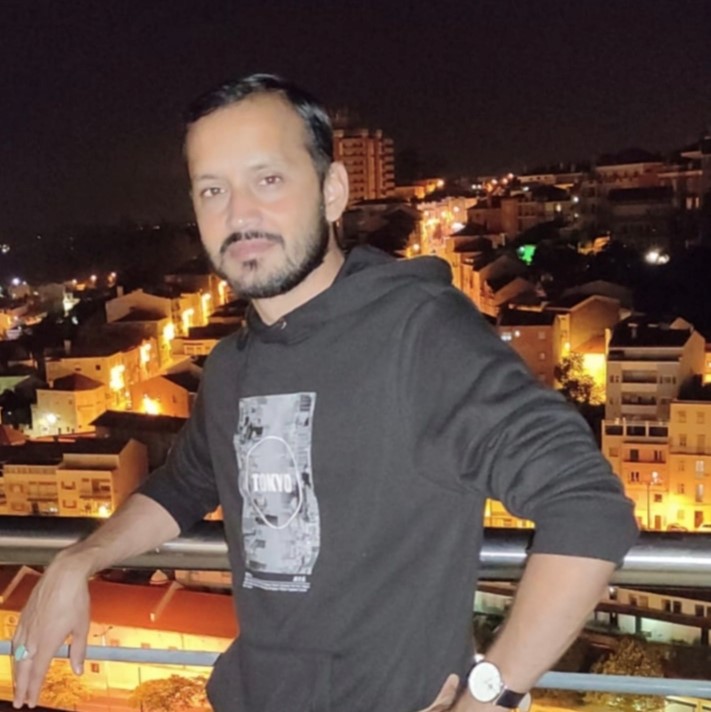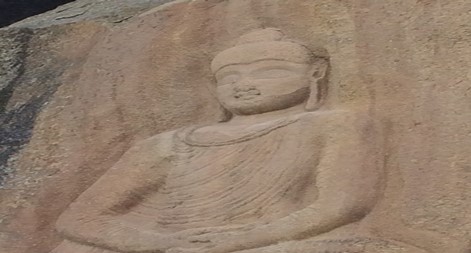Voices from the Sylff Community
Oct 6, 2023
The Interdependence of Heritage Tourism and Peace: Media Treatment of the Destruction and Rebuilding of the Jahanabad Buddha Statue in Pakistan
The tourism industry relies heavily on peace and security, so the destruction of heritage sites by terrorist groups represents a major threat. Farhad Nazir (University of Coimbra, 2022) undertook a study of media reactions to the defacement of a large, seventh-century Buddhist statue in Swat, Pakistan, and its subsequent restoration. This Voices article is based on a paper that was originally published in the International Journal of Tourism Cities.
* * *
There exists a significant historical connection between tourism and peace (Farmaki 2017, Farmaki & Stergiou 2021, Salazar 2006). With the exception of dark tourism and such categories as adventure and extreme sports, the majority of tourist activities are predicated on peace and security. A lack of social, environmental, economic, or political security is widely recognized as a significant obstacle to tourism. Nevertheless, due to precarious climatic conditions and rising political tensions, it is becoming increasingly difficult—at times almost impossible—to avoid encountering natural calamities, political upheavals, or terrorist activities.
This article seeks to analyze the links between heritage tourism and peace, drawing on a study in which I analyzed the content of 40 news sources to examine the demolition and subsequent reconstruction of the Seated Buddha of Jahanabad. The objective of the study was to explore the impact of peaceful conditions on cultural tourism.
Destruction and Reconstruction
Shortly after the application of Sharia law in Swat, Pakistan, the Tehrik-i-Taliban Pakistan (TTP) launched an attack on the Jahanabad Buddha statue in 2007. The defacement of the statue was confirmed following two explosions, as depicted in Figure 1. To win popular support and elicit sympathy, the TTP employed the tactic of iconoclasm and proclaimed their attacks as a success over Buddhist idols (De Nardi 2017).

Figure 1. Statue after destruction, September 2007. Source: Italian Archaeological Mission in Pakistan.
The act of terrorism aimed at demolishing the seated Buddha statue in Jahanabad was meant to communicate a message to both the local population and the international community. It sought to persuade individuals adhering to the Islamic faith that there would be no space for remnants of cultural or historical significance unrelated to Islam, emphasizing that Swat is exclusively a territory regulated by the Sharia legal framework.
However, the examination of Islamic teachings in the Holy Quran, Hadith, Sharia, and works of Fuqaha through discourse analysis has consistently reaffirmed the recognition of the rights of those who do not adhere to the Islamic faith, including their property rights and the protection of their sacred places of worship. Nevertheless, scholars from many backgrounds have raised objections to Islam’s purportedly tolerant attitude towards individuals who do not adhere to its beliefs (Michel 1985). It is noteworthy that during the self-proclaimed rule of the TTP in the Swat valley, the act of demolishing the Buddhist monument was carried out on religious grounds. And to substantiate their motives, the militants employed an anti-idol manifesto.
The military operation conducted in Swat in 2009 successfully eradicated the presence of TTP terrorists in the Swat valley, thereby reinstating the authority of the state. The Italian Archeological Mission, in collaboration with provincial and federal archaeological organizations, the Pakistan army, and the local population, has initiated efforts to reconstruct the heritage sites that have been destroyed, specifically focusing on the restoration of the Jahanabad Seated Buddha (De Nardi 2017, Tanweer 2011, Olivieri et al. 2019). The local community enthusiastically engaged in the process of reconstruction, demonstrating a commitment to the deeply ingrained cultural values and transcending religious differences. The restoration phase of the Buddha statue was successfully concluded in 2016 as a result of these collective efforts (De Nardi 2017, Lone 2019). Thanks to the collaborative endeavors of several stakeholders, the restoration of this remarkable site to its original form has successfully been achieved, reinstating it as one of the prominent cultural landmarks in the valley (see Figure 2).
Methodology
The study I and my colleagues at the University of Coimbra —Norberto Santos and Luis Silveira—conducted on the links between heritage tourism and peace employed a qualitative research approach, transcribing the textual and visual content of media news using the NVivo 12 interface. The data obtained consisted of two sets: media coverage of the demolition phase in 2007 and that of the subsequent rebuilding efforts from 2012 to 2016. Several national, regional, and international news agencies covered the destruction and rebuilding event. British Broadcasting Corporation (BBC), Agence France-Presse (AFP), Arab News, Deutsche Welle (DW), Voice of America (VOA), Turkish Radio and Television (TRT), World Is One News (WION), and South China Morning Post were among the international and regional media outlets, while notable national media included the Associated Press of Pakistan (APP), Express News, Geo News, Radio Pakistan, Dawn News, The Nation, and Express Tribune. We employed a hierarchical approach to conduct thematic analysis, wherein nodes, sub-themes, and themes were identified.
The findings shed light on six different themes: peaceful imagery, heritage dissonance against interfaith harmony, peace allegory via restoration, precursor of heritage sustainability, community heritage consonance, and heritage touristic valuation.
Implications
Our research findings have broad implications for various stakeholders as well as for the general public. From a commercial perspective, there exist possible pathways and opportunities for the revival of the tourism industry at this significant heritage site. Drawing inspiration from community activism, a similar approach may be employed to foster community stewardship of the Swat heritage sites, emphasizing their importance, value, and preservation. In addition, referencing the UN Sustainable Development Goals could enhance the significance of this innovation.
The study offers insights for both general readers and academic scholars, as it focuses on the physical and cultural aspects of Swat—a district with a Muslim majority population and heritage sites that are not associated with Islam. It examines the complex relationship between heritage, terrorism, peace, and tourism. The implications encompass several touchpoints involving site management authorities, the supplier sector, and entrepreneurs.
Our research also examined the strategies for protecting tourist destinations both before and after a destructive event occurs, with a focus on possible impacts on tourism activities. We hope that this study serves as a wake-up call for legislative players in terms of governance, prompting them to develop a counter-terrorism policy in anticipation of potentially disruptive activities.
Encouraging Further Study
The study surveyed the news content of a small number of national and international media organizations using a qualitative research paradigm. These limitations, though, can act to encourage future studies—extending the data collection portals to prominent social media sites, for example—to unveil new details about the issue under probe. Further, the inclusion of incidents at other national and international heritage sites could result in novel research insights. Comparative studies on similar issues in the regional and global context would also offer insights into the synergy of heritage, tourism, terrorism, and peace.
This research received support from the Centre of Studies in Geography and Spatial Planning (CEGOT), funded by the Foundation for Science and Technology (FCT) of Portugal, under reference UIDB/04084/2020 and from the Ryoichi Sasakawa Young Leaders Fellowship Fund, administered by the Tokyo Foundation for Policy Research.
References
De Nardi, S. (2017). “Everyday Heritage Activism in Swat Valley: Ethnographic Reflections on a Politics of Hope.” Heritage & Society, 10(3), pp. 237–258.
Farmaki, A. (2017). “The Tourism and Peace Nexus.” Tourism Management, 59, pp. 528–540.
Farmaki, A. and Stergiou, D. (2021). “Peace and Tourism: Bridging the Gap through Justice.” Peace & Change, 46(3), pp. 286–309.
Lone, A. G. (2019). “The Scope of the Buddhist ‘Workshops’ and Artistic ‘Centres’ in the Swat Valley, Ancient Uḍḍiyāna, in Pakistan. In W. Rienjang & P. Stewart, eds., The Geography of Gandhāran Art (pp. 107–120). Archaeopress Archaeology.
Michel, T. (1985). “The Rights of Non‐Muslims in Islam: An Opening Statement.” Journal of Muslim Minority Affairs, 6(1), pp. 7–20.
Olivieri, L. M., Marzaioli, F., Passariello, I., Iori, E., Micheli, R., Terrasi, F., Vidale, M., & D’Onofrio, A. (2019). “A New Revised Chronology and Cultural Sequence of the Swat Valley, Khyber Pakhtunkhwa (Pakistan) in the Light of Current Excavations at Barikot (Bir-kot-ghwandai).” Nuclear Instruments and Methods in Physics Research Section B: Beam Interactions with Materials and Atoms, 456, pp. 148–156.
Salazar, N.B. (2006). “Building a ‘Culture of Peace’ through Tourism: Reflexive and Analytical Notes and Queries.” Universitas Humanística (62), pp. 319–336.
Tanweer, T. (2011). “Italian Archaeological Activities in Swat: An Introduction.” Journal of Asian Civilizations, 34(1), pp. 48–80.

